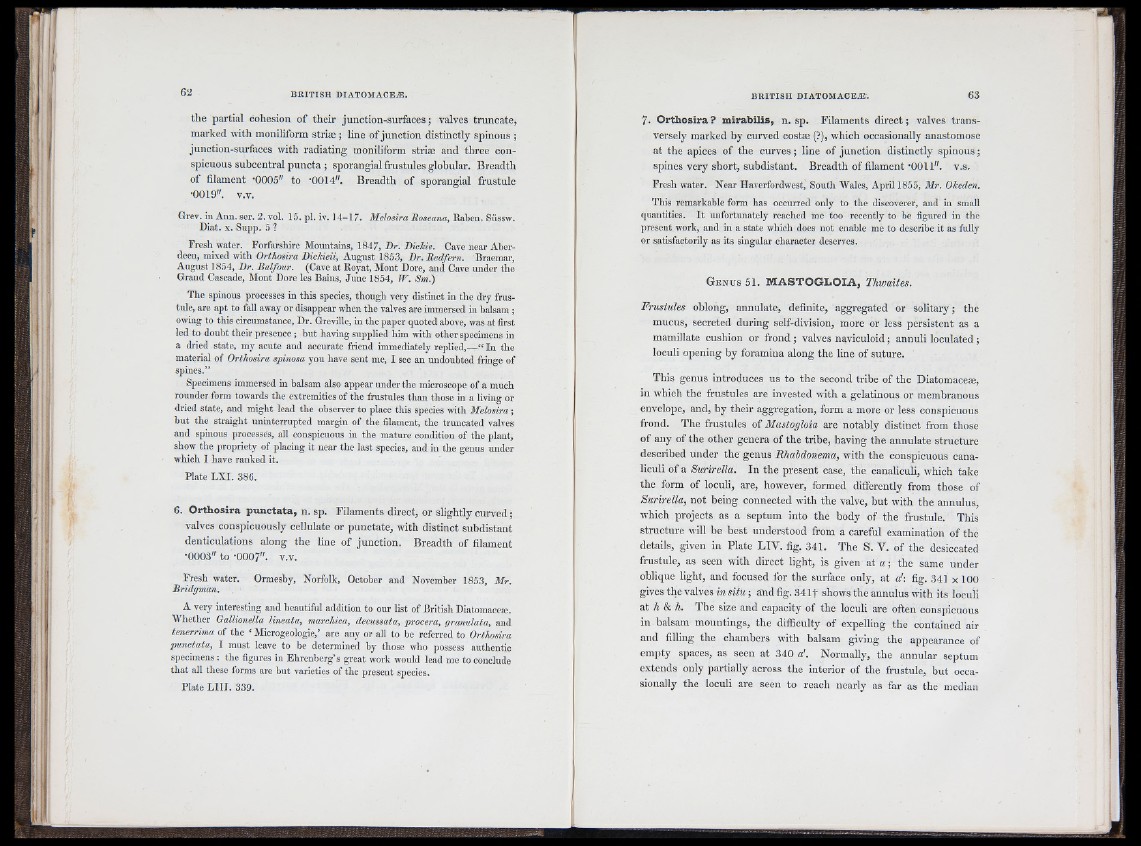
l'íí ' H
|i i)
Ii5 !
t l
fl ^^
(I
the partial cohesion of their junction-surfaces; valves truncate,
marked with moniliform striæ ; line of junction distinctly spinous ;
junction-surfaces with radiating moniliform striæ and three conspicuous
subcentral puncta ; sporangial frustules globular. Breadth
of filament -0005" to '0014". Breadth of sporangial frustule
•0019". v.v.
Grev. in Ann. ser. 2. vol. 15.pl.iv. 14-17. Me/oszVa Jioseana, Raben. Süssw.
Diat. X. Supp. 5 ?
Fresh water. Forfarshire Mountains, 1847, Dr. Dickie. Cave near Aberdeen,
mixed with Orthosira Dickieii, August 1853, Dr. Bedfern. Braemar,
August 1854, Dr. Balfour. (Cave at Royat, Mont Dore, and Cave under the
Grand Cascade, Mont Dore les Bains, June 1854, W. Sm.)
The spinous processes in this species, though very distinct in the dry frustule,
are apt to fall away or disappear when the valves are immersed in balsam ;
owing to this circumstance, Dr. Greville, in the paper quoted above, was at first
led to doubt their presence ; hut having supplied him with other specimens in
a dried state, my acute and accurate friend immediately replied,—“ In the
material of Orthosira spinosa you have sent me, I see an undoubted fringe of
spines.”
Specimens immersed in balsam also appear under the microscope of a much
rounder form towards the extremities of the frustules than those in a living or
dried state, and might lead the observer to place this species with Melosira;
but the straight uninterrupted margin of the filament, the truncated valves
and spinous processes, all conspicuous in the mature condition of the plant,
show the propriety of placing it near the last species, aud in the genus under
which I have ranked it.
Plate LXI. 386.
6 . Orthosira punctata, n. sp. Filaments direct, or slightly curved;
valves conspicuously cellulate or punctate, with distinct subdistant
denticulations along the line of junction. Breadth of filament
•0003" to -0007". v.v.
Fresh water. Ormesby, Norfolk, October and November 1853, Mr.
Bridgman.
A very interesting and beautiful addition to our list of British Diatomaceæ.
■Whether GalUonella lineata, marchica, decussata, procera, granulata, and
tenerrima of the ‘ Microgeologie,’ are any or all to be referred to Orthosira
punctata, I must leave to be determined by those who possess authentic
specimens : the figures in Ehrenberg’s great work would lead me to conclude
that all these forms are but varieties of the present species.
Plate LIII. 339.
7. Orthosira ? mirabilis, n. sp. Filaments direct ; valves transversely
marked by curved costæ (?), which occasionally anastomose
at the apices of the curves; line of junction distinctly spinous;
spines very short, subdistant. Breadth of filament •OOI 1". v.s.
Fresh water. Near Haverfordwest, South Wales, April 1855, Mr. Okeden.
This remarkable form has occurred only to the discoverer, and in small
quantities. It unfortunately reached me too recently to be figured in the
present work, and in a state which does not enable me to describe it as fully
or satisfactorily as its singular character deserves.
G e n u s 51. MASTOGLOIA, Thwaites.
Frustules oblong, annulate, definite, aggregated or solitary; the
mucus, secreted during self-division, more or less persistent as a
mamillate cushion or frond ; valves naviculoid ; annuli loculated ;
loculi opening by foramina along the line of suture.
This genus introduces us to the second tribe of the Diatomaceæ,
in which the frustules are invested with a gelatinous or membranous
envelope, and, by their aggregation, form a more or less conspicuous
frond. The frustules of Mastogloia are notably distinct from those
of any of the other genera of the tribe, having the annulate structure
described under the genus Rhabdonema, with the conspicuous canaliculi
of a Surirella. In the present case, the canaliculi, which take
the form of loculi, are, however, formed differently from those of
Surirella, not being connected with the valve, but with the annulus,
which projects as a septum into the body of the frustule. This
structure will be best understood from a careful examination of the
details, given in Plate LIV. fig. 341. The S. V. of the desiccated
frustule, as seen with direct light, is given at a ; the same under
oblique light, and focused ibr the surface only, at a'; fig. 341 x 100
gives the valves in situ ; and fig. 34 1 t shows the annulus with its loculi
at h & h. The size and capacity of the loculi are often conspicuous
in balsam mountings, the difficulty of expelling the contained air
and filling the chambers with balsam giving the appearance of
empty spaces, as seen at 340 a'. Normally, the annular septum
extends only partially across the interior of the frustule, but occasionally
the loculi are seen to reach nearly as far as the median